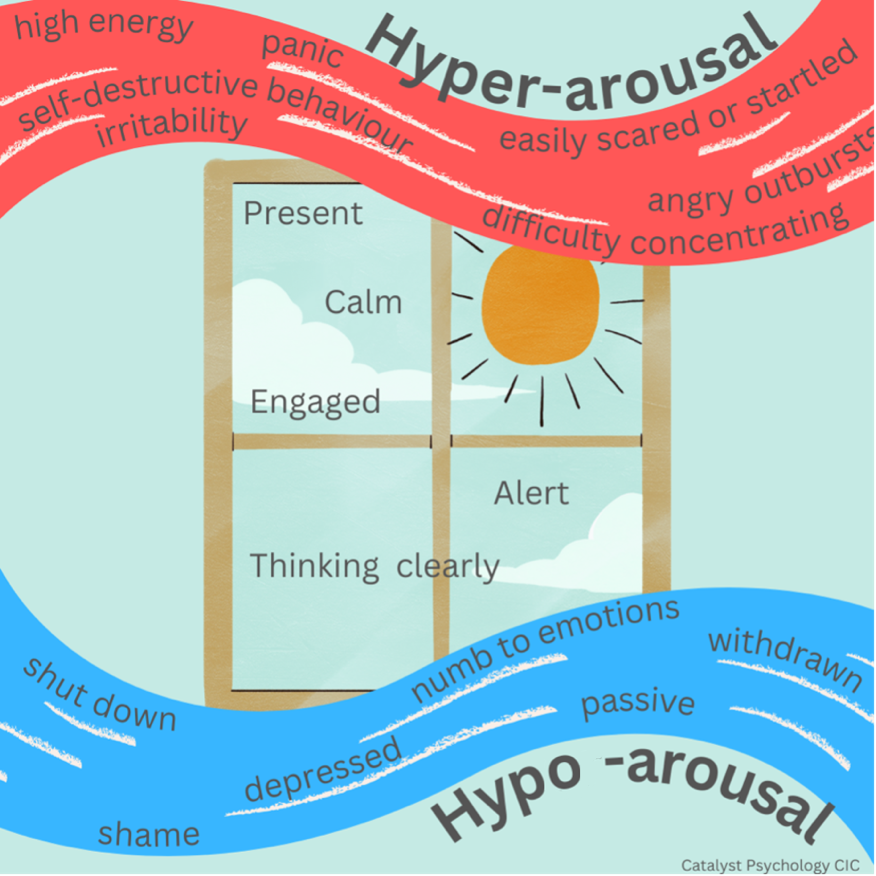As babies, when we have healthy attachment with attuned, available, and nurturing caregivers, we lay the foundations for the optimal development of our brain and nervous system. The co-regulation offered by caregivers, e.g. rocking, soothing, making eye contact, responding to cries, teaches our nervous system how to return to calm after stress. Over time, this gives us the ability to self-regulate independently as we grow older.
But what happens if this foundation is disrupted? Or if trauma, loss, or overwhelming life experiences come into play later in life? This is where the Window of Tolerance comes in.
What is the Window of Tolerance?
The term Window of Tolerance was coined by Dr. Dan Siegel to describe the range of emotional and physiological arousal we can experience while still being able to function and cope effectively.
When we are within our window, we can ride the ups and downs of life: hurt, anxiety, sadness, pain, anger, and still find our way back to balance. For example, you might feel stressed before a presentation, but after taking a few deep breaths, talking it through with a friend, or finishing the presentation itself, you can return to calm.
We all fluctuate in arousal during the day, it’s normal to get excited, worried, tired, or discouraged, but if we have strategies and enough capacity in our nervous system, we can find our way back without becoming overwhelmed.
When we are pushed outside the window, though, things change:
Hyperarousal (too much activation): fight/flight energy, anxiety, panic, anger, overwhelm, hypervigilance.
Hypoarousal (too little energy): shutdown, numbness, depression, exhaustion, disconnection.
The below diagram usually shows how we move in and out of the window, with periods of activation followed by settling.
Trauma and Attachment Wounds
When we experience trauma or have unmet attachment needs, our nervous system’s natural capacity to self-regulate can be disrupted.
Our senses may become heightened.
Experiences and emotions feel more intense.
Strategies that usually work (breathing, distraction, self-talk, connection) may no longer be accessible.
Our window of tolerance shrinks, giving us less space to ebb and flow with life’s ups and downs.
This is why someone with unresolved trauma may feel overwhelmed by things that seem “small” to others, it’s not a matter of willpower or weakness, but of nervous system capacity.
Learning how to track and shift emotions becomes a powerful tool for widening this window again, so that regulation and integration are possible throughout the body, mind, and brain. Without this, people often get stuck in “On” (hyperarousal) or “Off” (hypoarousal).
To further understand these states:
Calm Arousal is optimal. We move in and out of this range naturally all day long.
Hyperarousal happens when fear, pain, anger, or trauma triggers overwhelm us. The nervous system gets stuck on “On”, racing thoughts, rapid heartbeat, hypervigilance, inability to rest or sleep, emotional flooding, including dissociative rage.
Hypoarousal often comes after too much hyperarousal. When the overwhelm surpasses what the brain and body can tolerate, we shut down. The nervous system gets stuck on “Off”, numbness, exhaustion, flat affect, depression, disconnection, loss of appetite, sleeping excessively, etc.
Interestingly, the nervous system doesn’t let us stay in one state forever. For example:
After too much anxiety, the body may numb itself into shutdown.
After too long in shutdown, people may gravitate toward risky or stimulating behaviors (drugs, thrill-seeking, conflict) just to feel alive again.
This seesaw can become a survival pattern when regulation hasn’t been learned or embodied.
Without healthy co-regulation in childhood, or when trauma is unresolved, people often turn to whatever strategies they can find to regulate:
Someone with excessive fear or anxiety (hyperarousal) may use depressants (alcohol, sedatives) to quiet their system.
Someone feeling flat or disconnected (hypoarousal) may seek stimulants (caffeine, sugar, drugs, risky behavior) to feel alive again.
The problem is that these strategies don’t create lasting regulation. The true goal is to help the nervous system to learn safer, natural, and healthier pathways to bring it back into balance.
Co-Regulation in Action: Broadening the Window
Parents, partners, and loved ones can support this process by:
Naming what they see: “It looks like you’re feeling overwhelmed. Do you want to take a break?”
Offering presence and grounding: a calm voice, gentle touch, or simply sitting quietly with someone.
Encouraging mindful noticing: “What do you feel in your body right now? What might help you feel better?”
Dr. Siegel calls this “name it to tame it”, naming emotions helps reduce their intensity, creating a sense of validation and being seen.
When children, teens, or adults practice noticing sensations, emotions, and needs, they begin to rewire their nervous system toward greater resilience.
Ultimately, healing means expanding the window of tolerance so that:
People can experience a wider range of emotions without being thrown into dysregulation.
The nervous system has more flexibility and resilience.
Life feels more spacious, grounded, and livable.
By cultivating co-regulation, self-awareness, and trauma-informed tools, we can grow our capacity to move through emotional intensity and return to calm once more.





